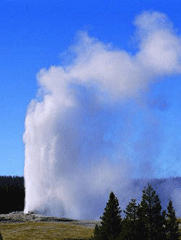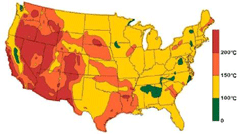Geothermal Energy Heats Up
Air Date: Week of October 31, 2008

Federal officials won’t tap Old Faithful for geothermal energy, but they do hope to capitalize on other geysers in the geologically active West. (Courtesy of Idaho National Laboratory)
The United States currently produces more geothermal energy than any other country in the world. Now, the Department of Interior wants to increase that ten- fold by making 190 million acres of public land available for geothermal exploration. Host Bruce Gellerman reports.
Transcript
GELLERMAN: The answer to our energy needs could be right under our noses, or more accurately, right under our feet: it’s geothermal energy, and advocates say by mining into the earth’s heat we can release a virtually inexhaustible supply of clean power, which requires no fossil fuels, produces little greenhouse gases, and can generate electricity about as cheaply as burning coal. It’s simple - drill a hole in a hot spot, and tap the heated water and steam that comes out.
Geothermal is a proven technology. There are geopower plants around the world - one in Italy has been producing energy for over a hundred years - but the United States is, by far, the world geothermal leader. We get as much electricity from geothermal energy as solar and wind combined. And the Department of the Interior has big plans for geothermal. It just announced it’s opening up 190 million acres of federal land in 12 western states to geothermal development. That’s an area twice the size of California.

The best geothermal hot spots are located west of the Rocky Mountains.
BRADY: Right now we have just over 1,200 megawatts of geothermal capacity. That’s enough electricity to power approximately 1.2 million homes. We could potentially increase that production by fivefold by the year 2015. By 2025 that capacity could potentially power twelve million homes.
GELLERMAN: The plan permits private energy companies to bid on public land. Half the revenue from the leases would go to the state, a quarter to the federal government and a quarter to local counties. We’re talking big bucks. Just three geothermal leases recently went for $52 million. Of course being public land, the 192 million acres include some of the most environmentally sensitive open spaces in the country. Ray Brady says the Department of the Interior has come up with a programmatic environmental impact statement that puts many of the areas off limits to geothermal exploitation.
BRADY: And this would include all wilderness areas, wilderness study areas, sensitive resource lands, areas that are designated as national parks, national monuments, national conservation areas, etc. So there is a lot of the very sensitive resource lands that are not available for geothermal leasing.

Ray Brady is Energy Team Leader for the Bureau of Land Management.
BRADY: We would not. No.
GELLERMAN: Mining all that heat energy in the earth is one thing, turning it into electricity is another. Ray Brady acknowledges geothermal plants will have environmental impacts.
BRADY: There will be surface facilities. There will be wells and well pads. There will be pipelines that transmit the hot fluids and steam to the generating facility. There will be the plant facility itself. There will be access roads. Try to keep the footprint to the minimum possible - however, there will be surface disturbance, yes.
GELLERMAN: And there will need to be new transmission lines to get the electricity to market. Thousands of miles of overhead lines are already being built in western states. But there are concerns about the environment under the ground as well. There are fears geothermal plants could trigger earthquakes.
BRADY: You know many of these geothermal resources are in geologically active areas. So there’s some likelihood that that might potentially occur, and that’s another one of the reasons that you are reinjecting fluids back into the ground to insure that you have a stable geologic environment.
GELLERMAN: Recirculating the water back into the ground also solves two other problems. Geothermal hot water can be highly acidic and slightly radioactive. But as ambitious as the federal government’s new190 million acre geothermal plan is, it pales in comparison to the potential promise of a new technology called Enhanced Geothermal Energy. Michael Fehler is a Senior Research Scientist at MIT and a corporate geothermal consultant.
FEHLER: The idea is to drill holes and make a manmade geothermal system. And so what we do is we drill a hole, and we use something called hydraulic fracturing to create a fracture system that water can flow through. And then we drill another well into that fracture system so now we have two wells that are drilled into a fracture system. We inject water into one of them, and it flows through the fractures, absorbs heat from the earth, and it comes up hot. And then we can take the heat from that water and convert it into energy.

Federal officials won’t tap Old Faithful for geothermal energy, but they do hope to capitalize on other geysers in the geologically active West.(Courtesy of Idaho National Laboratory)
FEHLER: The hope is that a given well pair – you need two, at least two wells – could last twenty to thirty years. When people look at how they might develop a field, they think of developing several well pairs over time so that as one well pair started phasing out, your power plant would still be usable, have a usable lifespan, and basically extend the life of your geothermal resource within the area. So, in that way you could go on probably several centuries in a given region.
GELLERMAN: Potentially, enhanced geothermal opens up the entire planet for energy production. MIT researchers estimate that the earth’s usable geothermal energy could supply the world’s needs for a quarter of a million years. Professor Fehler:
FEHLER: I don’t think geothermal can completely solve the energy problem, but I think it can contribute to the mix. And I’m hopeful that it will. Google is investing in geothermal now. So, you know, I think, you know we’re seeing not only government but entrepreneurs getting interested in this technology
GELLERMAN: Professor Fehler emphasizes enhanced geothermal is still just experimental. But stay tuned. It’s hot.
[MUSIC: Daniel Lanois "O Marie" from 'Acadie' (Daniellanois.com – 2005)]
Links
Living on Earth wants to hear from you!
Living on Earth
62 Calef Highway, Suite 212
Lee, NH 03861
Telephone: 617-287-4121
E-mail: comments@loe.org
Newsletter [Click here]
Donate to Living on Earth!
Living on Earth is an independent media program and relies entirely on contributions from listeners and institutions supporting public service. Please donate now to preserve an independent environmental voice.
NewsletterLiving on Earth offers a weekly delivery of the show's rundown to your mailbox. Sign up for our newsletter today!
 Sailors For The Sea: Be the change you want to sea.
Sailors For The Sea: Be the change you want to sea.
 The Grantham Foundation for the Protection of the Environment: Committed to protecting and improving the health of the global environment.
The Grantham Foundation for the Protection of the Environment: Committed to protecting and improving the health of the global environment.
 Contribute to Living on Earth and receive, as our gift to you, an archival print of one of Mark Seth Lender's extraordinary wildlife photographs. Follow the link to see Mark's current collection of photographs.
Contribute to Living on Earth and receive, as our gift to you, an archival print of one of Mark Seth Lender's extraordinary wildlife photographs. Follow the link to see Mark's current collection of photographs.
 Buy a signed copy of Mark Seth Lender's book Smeagull the Seagull & support Living on Earth
Buy a signed copy of Mark Seth Lender's book Smeagull the Seagull & support Living on Earth

